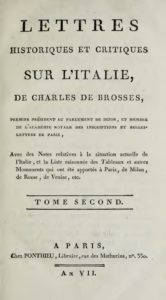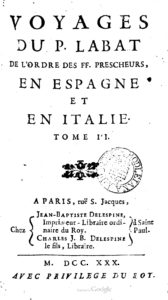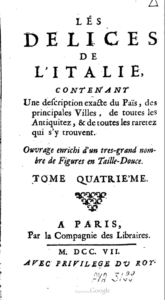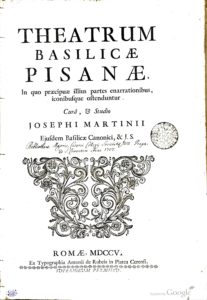Chapter XIX. About the Paintings of the Cemetery
As we have talked about the tombs, what remains to be discussed is the pictures that are on all of the walls of the cemetery. In order that sacred history may be viewed in its proper order, let us begin with the Beginning of the World. Therefore, we begin far in the north, where the extremely great eternal fathers, embracing with their arms the hierarchy of the angels, the celestial sphere, the elements and the whole earth mass, are to be seen. This picture shows St. Augustine and St. Thomas among angels, which the Florentine Buonamico Buffalmaco drew with refined expression. This sequence is followed by a great knowledge of invisible God. I believe it says:
‘You, who see this painting / Of God, the merciful, supreme Creator / Who makes all things with love / Balanced, counted and measured / In nine stages the nature of angels / In this heavenly realm full of glory / The unmoved mover / Makes every thing good and pure / Lift up the eyes of your mind / Consider how much and how orderly / The whole world and with love. / Praise him for how well he has done / Remember to pass into such joy / Between the angels, where all are blessed’
The other part of the wall, towards the south, shows the famous story of the brave Job, painted by the outstanding Florentine Giotto, drawn with elegant colors and divided into six parts. In this picture, closest to the rest, the bad news that befell Job is portrayed with unique, dignified attention. Just as the shepherd is in pain over the loss of the flock of sheep and other evils, the story comes alive. In the other pictures, the same Job is seen, himself as a witness on a dung heap, with a foul ulcer filled with bloody pus. The other figures are also, as the same Vasari says in Part I, page 123, excellently represented by size. And Giotto, at that time, gained a reputation whereupon the supreme pope Benedict XI, called XII, ordered him brought to paint with his brush the sacred stories in Saint Peter’s, the venerable temple. The aforementioned paintings were damaged by the injustice of time or were gnawed because of the salinity in the air. Johannes Stephanus de Marucellis restored the elegant colors around the middle of the last century.
After the life of Job, many saints, martyrs, and confessors follow, whose execution was highly acclaimed. This is followed by four new ones, namely the Triumph of Death, the Last Judgment, Hell, Paradise, and in the same cemetery we see the face of our Lord Savior on the cross and the glorious Resurrection of the same. Next we encounter images of holy martyrs. The Saints Ephesus and Potitus, executed in the strongest manner and bearing signs of the Lord Spinello Aretino, are painted with excellent colors. In these, one sees how Saint Ephesus receives the signs against the believing Christians from the Emperor. But soon after, by divine providence, he receives from the hand of an angel the flag of faith with a white cross on a red background, so that he does not persecute Christ. In the other pictures, we see how the same martyr is tortured and how the saint is appropriately transferred from the island of Sardinia to Pisa. To this transfer can be added, of course, where the Savior sings of the mysterious fertility of Sardinia. […]
In the following six pictures, the life of the excellent St. Ranieri, a Pisan confessor, was excellently depicted by Simone Memmi from Siena and by Antonius, who is commonly called Veneziano. The former blossomed in the middle of the 13th century, the latter towards the end. Many things are depicted in the first panel, including how St. Ranieri sings about beautiful women with great joy, until Blessed Albertus admonishes him that he is committing a crime, whereupon he falls into enormous sorrow and sheds tears. Another shows holy goods being distributed to the poor, and, in the next, St. Ranieri getting on the ship is represented. In another, how St. Ranieri confides in the lame, the blind and poor women with children is portrayed. The excellence of the deeds is shown when all who actually asked for alms express gratitude for them. In the following picture, you can see the Blessed Virgin appearing to St. Ranieri in the city of Tyre, as we mentioned above on page 37. In another, one sees the man of God represented to whom Moses and Elijah appear by divine command. In the other pictures, the praised Antonio Veneziano painted St. Ranieri returning to the fatherland by ship in the finest way. Many other paintings also astonish us, as when the man of God exposes a certain grocer who placed his barrel under the picture of a cat and adulterated the divine wine with water by making the wine flow on the earth. The painting where the servant of the Lord dies deserves no less attention. A singing group of people carries the miracle worker and they are depicted with singing, open mouths and carrying the corpse. As the holy body is brought to the largest church, a crowd of people, the needy, the blind and the lame, is healed . This is painted in color, as you know. The images mentioned, which are not equivalent, are useful despite their age, to capture the deeds of the saint, although in certain places biting time has gnawed at them or they are corroded by the salt that lets in the air. Three images are badly affected by this and a total of twenty-seven. Then we follow the admirable life of the Holy Fathers, depicted in works of art. First, we see the father Paphnutius, skillfully painted by Antonio Veneziano. We have not given up the study of ancient things in this dignified place and next we come to the inscriptions of Canon Roland from Pisa. In the other paintings, we see many religious people in seclusion. The others, however, surrender to contemplation on the holy mountain. Other activities aimed at the preparatory way of life are depicted. Here, however, it is more remarkable in that all the images of the famous Peter Laureato are artfully depicted. Indeed, we will refrain from indulging in brief descriptions of those. Next, the torture house is shown, painted with the signs of Bernardo Orgagna of Florence. Various general punishments and countless sentences are artfully depicted here. You see with burning eyes how devilish miracles of great proportions pour down in the middle against the burning pulpit and further evil deeds torment the souls. The next picture depicts the Last Judgment, skillfully painted by Andrea Orgagna, the brother of the aforementioned Bernardo. There, it has large seats where the apostles are distributed on benches and where Christ sits down with dignity. Here, angels bear the cross, the crown of thorns, the lance, the scourge, the ropes and other instruments of the Holy Passion. The Blessed Virgin is sitting down not far from it. The damned come from the right, while from the left the saints come and rejoice. In the area on the right side stand the crowd of the chosen, while next to it, on the left, is the crowd of the damned, being thrown into the underworld. In the center, one sees the tombs from which the bodies of the dead emerge united with the souls. Here, a hypocrite, who has joined the chosen crowd, is driven away by an angel to the place of the damned. As for Solomon, whose salvation is not considered assured, the painter has placed him neither on the left nor on the right, but he is seen laboriously emerging from his tomb himself. In the Judgment scene, the artist has painted in the waiting crowd many friends and benefactors, among whom, as Vasari said, Pope Innocent IV is shown. In the next picture, the image of the Triumph of Death is shown, where the following words are to be read:
The display of knowledge and wealth / Of nobility and valor / Is nothing against the blow of this
Through the air in the form of an abominable old woman with black wings, Death flies to the dead carrying a sickle in front of her. Below, a great heap of cadavers protrudes; there, popes, emperors and princes are shown with the poor, slaves and peasants mixed with others above others. From the mouths of the righteous, the angels take the souls from the human bodies, as expressed by the artist. The devils, in fact, tear them out of the mouths of the damned. Not visited [by Death] is the crowd of the lame, the poor and the old, who plead and strive for death because they want to be redeemed from their miserable life on the last day. But she repels their prayer and directs the sickle to the others. She directs it against the young men who, in the green and listening to strains of songs, spend life in luxury together with women who play the zither; the man who holds the hawk in his hand is the image of the Duke of Castrucci, as they say. Above the next mountain, many scenes are depicted where death is expected. At the lower corner, coffins are seen containing the bodies of three dead kings, one still fresh, another bloated, and the third truly showing only the bones. The artist thus shows the now obsolete belief that the earth has the power to turn bodies into a state of dust in twenty-four hours, as Nathan Chytraeus sings about in his verses:
Ancient splendor is still left in this monument
Splendid marble brilliantly covers the columns
The tower and the gate threaten to topple
You see it hanging from within, a great field
By the honor of the Roman Decius, by supreme justice
It was founded, where in 24 hours
The bodies buried in this earth decompose
Near the aforementioned coffins, one sees many horsemen, of which the one who holds his nose is Louis of Bavaria, as they say. Another is Uggocione, called della Faggiola, and the third is in fact Emperor Frederick, called Barbarossa. Not far back are the days when the deceased were remembered and a throne belonging to the burial was brought to the wide field, above which an altar rises, where the holy mass for the deceased was celebrated with the participation of the entire clergy, who, after the second celebration of Vesper, came in procession to read to the dead at Vesper in front of a large crowd. The next picture on the front of the cemetery was artistically drawn by Buffalmacco. Here, the firstborn, the Lord Jesus Christ, died hanging on the cross with the thieves. As well as the cross, the Blessed Virgin is seen being pierced by pain, along with many more looking on at the Crucifixion, such as returning soldiers and a crowd of people. In the other large paintings, the Resurrection of the Savior is depicted, where the following words are written:
At your resurrection Christ / Heaven and earth hail you with hallelujahs.
And not far in this picture, God is also seen gloriously ascending to Heaven, where this word can also be seen:
All people clap their hands and cheer God / God ascends rejoicing and the Lord is accompanied by trumpets
This inscription was perhaps placed in this place to dispel death and also other fears. For when Christ the Lord rises, we also rise. St. Augustine, in the third discourse on the Resurrection, says that all the miracles God has performed in this world benefit us in our frailty. For he has brought about the condition of man through the stars, and through faith in Heaven you can endure it, as he has shown. And then, through the victory over death, he has raised himself to Heaven, and through this he shows that they can follow.
Therefore, writes St. Leo in the third discourse on the Resurrection of the Lord, Christ’s Resurrection is our salvation. And if you understand his glorious ascension, his hope and his body is called, we would rejoice, so we are pleased with pious gratitude.
Let this refined building and the even better construction be recorded and the interior of this building, which we will place before our eyes, can stand next to the vowed Andrea Pozzo of the Jesuit Order.





